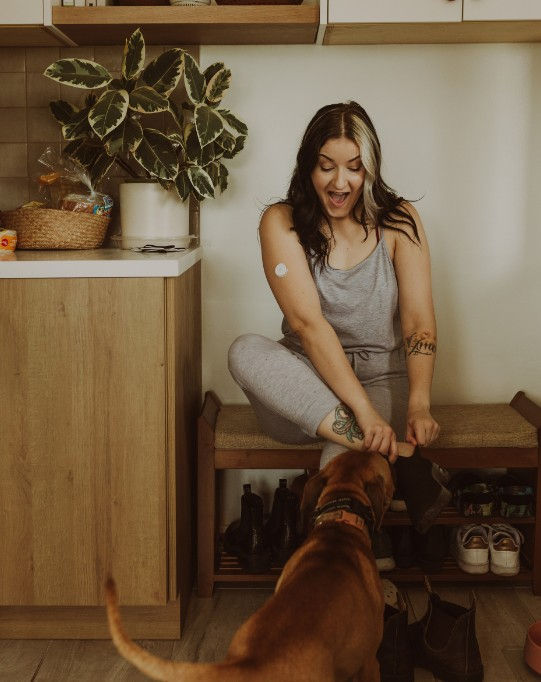Simplifying Diabetes Care: One Patient’s Journey
- Katlyn Agosta, MSN, APRN, FNP-C, CDCES

- Oct 11
- 4 min read
Managing diabetes doesn’t have to be complicated. Personalized care from a diabetes expert can make all the difference. This real-life story showcases how one woman went from diabetes burnout to feeling back in control.
🎧 Prefer to listen? Click play to hear the story.

Confusing.
That’s the word that came to mind the first time I heard what Linda* had been prescribed to manage her type 2 diabetes. The plan didn’t make sense, not because it was wrong, but from a personal diabetes burden standpoint, it was creating more work without added benefit.
Before we get into Linda’s treatment, let’s hear her backstory.
*This blog post is based on a real patient success story, though the name and other identifying details have been changed to protect the patient’s privacy.

Meet Linda
Linda is a fierce 52-year-old mobile pet groomer. She spends her days juggling customer calls, hauling equipment in and out of vans, shampooing (let’s be real, wrestling) dogs, and squeezing in meals while driving to her next appointment.
When I met Linda, she told me diabetes felt like another full-time job, and she was fed up with being told “let’s give it another three months” when she was already putting in so much work.
Here’s what she was being asked to do with her diabetes medications:
Inject Levemir 30 units twice daily (morning and night)
Inject Novolog 20 units three times daily before meals
Inject Ozempic 1mg once per week
Take Metformin 1000mg with breakfast and dinner
Check fingerstick blood sugar before each insulin dose (4-5 times daily)
Any way you slice it, that’s a complicated regimen. On paper, it could make sense and might work well for some—but in this case, I saw one glaring problem right away.
Linda’s Novolog was in a pen, while her Levemir came as a vial and syringe.
Why Insulin Delivery Method Matters
For anyone who’s never had to take insulin, switching between pens and syringes just doesn’t make sense.
Here’s why:
It increases the overall cost of diabetes management. Now you’re buying both pen needles and insulin syringes.
It doubles the learning curve. You (or your family member) have to master two completely different injection methods.
It adds unnecessary confusion, accelerating diabetes burnout without offering any real benefit.
So why was Linda doing both?
Simple: she’d originally been prescribed Levemir pens, but in April 2024 the manufacturer discontinued them. Her primary care provider switched her prescription to Levemir vials.

The Final Straw
By the time I met her, Linda was beyond frustrated. Her A1C in February 2025 was 9.1%, so her PCP added Ozempic. When she returned in May 2025, her A1C had dropped to 7.0% (great progress) but during that visit, she raised two important concerns:
She was having frequent low blood sugar readings after her Ozempic dose increased. Her provider told her to stop taking Novolog. Reasonable enough.
She was worried about a letter saying Levemir vials were being discontinued.
Her provider’s response? “We’ll cross that bridge when we get there.”
I couldn’t believe it either!
Simplifying Diabetes Care: One Step at a Time
When Linda joined our clinic, the first goal was simple: make her diabetes plan make sense again while keeping her safe.
We started by switching her Levemir to Tresiba U-200 insulin pens, a concentrated, once-daily option that improves dose absorption and fits better with her busy schedule.
Next, we discussed her concerns and transitioned from fingerstick testing to a continuous glucose monitor (CGM) so she could see trends in real time, No more guessing or juggling test strips.
We also changed her Metformin to the extended-release version, so she could take it just once a day. Dropping the Novolog was a good call, she didn’t need this anymore because Ozempic was doing the same job.
Finally, we optimized her Ozempic dose while closely monitoring blood sugar trends and adjusting her insulin to keep her safe.
These were big changes. Linda met with me once a month, and between visits, we checked in via text within a week of any dose adjustments.
Five Months Later, Diabetes Care Feels Different
Linda’s progress spoke for itself:
A1C: improved to 6.7%
Insulin dose: reduced from 60 to 50 units
CGM Time in range: 98% (exceeding the target of at least 70%)
Weight: down 7 pounds
Lows: eliminated completely

But beyond numbers, Linda feels better. Her clothes fit again. She has more energy. She’s learned how stress and exercise affect her blood sugar. She’s meal prepping, working out, and (most importantly) she feels like she’s back in control of her health, not the other way around.
Taking her pills once a day, one injection each morning, plus Ozempic once a week, fits her lifestyle. The CGM gives her peace of mind and empowers her to make lifestyle changes to move her closer to her goals. And when questions come up between visits, Linda knows she can text or call anytime.
At Papaya, that’s what diabetes care should feel like—simple, personal, and effective.
For Those in Florida (ages 18-64)
If your diabetes plan feels complicated, we can help. Schedule a no-obligation discovery call today and experience the difference of direct primary care.
Author's Note
This story was written by Katlyn Agosta, MSN, APRN, FNP-C, CDCES—a nurse practitioner and certified diabetes care and education specialist living with type 1 diabetes for over 20 years. She helps patients simplify and optimize their diabetes care with real-world strategies that fit their lives.
.png)


Comments